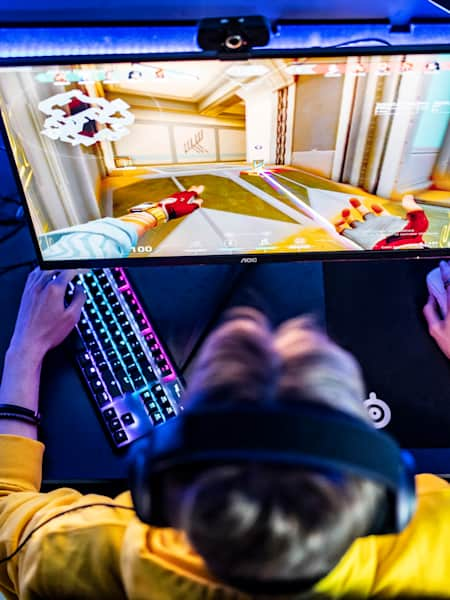Gaming
Milliseconds matter in the fast-paced world of VALORANT. Achieving low ping is necessary for an optimal gaming experience, where every shot, move, and strategy depends on the connection speed. High ping can lead to frustrating gaming latency, delaying actions and reducing the smoothness of gameplay. Thankfully, there are practical steps to reduce ping and enhance the VALORANT experience.
Whether it’s getting to the next level at Red Bull Home Ground NA Qualifier or vying for first prize at Red Bull Campus Clutch, minimizing ping is essential for VALORANT victory. Read ahead for a complete guide on how to reduce ping in VALORANT.
Participants compete during the 2023 Red Bull Campus Clutch at Istanbul
© Barış Acarlı / Red Bull Content Pool
Understanding ping and its impact
Ping, measured in milliseconds (ms), refers to the time it takes for data to travel from the computer to the game server and back. In online gaming, a lower ping translates to a more responsive and enjoyable experience.
A low ping in VALORANT means faster speeds to transfer data and receive the server’s response. A ping below 20 ms is considered excellent, while pings between 50 ms and 100 ms are considered very good to average. Anything over 150 ms can lead to noticeable delays and lag.
In the realm of esports, low ping is one of those details that can significantly impact performance. Whether it’s casual players or professionals, low ping helps gamers achieve their best performance. Gaming latency, caused by high ping, can result in delayed actions, missed shots, and a generally frustrating experience.
01
Tips to help fix ping
Check your internet connection
A stable and speedy internet connection is the backbone of low ping. Here are some tips to ensure the connection is up to the task:
- Wired vs. wireless connections: Whenever possible, use a wired Ethernet connection instead of Wi-Fi. Wired connections offer more stability and lower latency, reducing the chances of Valorant connection issues.
- Optimize router settings: Position the router close to the gaming device and away from obstructions. See if there are other devices connected to the router because the more that are connected, the more latency a gaming session experiences.
- Internet speed: Ensure the internet plan provides adequate speed for online gaming. While VALORANT doesn't require extremely high speeds, a minimum of 25 Mbps download and 1 Mbps upload speed is recommended.
Optimize your network settings
Learning how to adjust your network settings to prioritize VALORANT traffic can significantly enhance the gaming experience.
- Reduce network congestion: Avoid using bandwidth-intensive applications, such as streaming services or large downloads, to maintain network stability during online gaming. For streamers, look into increasing the bandwidth of the router to fix high ping.
- QoS settings: Configure the router’s quality of service (QoS) settings to prioritize any gaming traffic over other traffic. This can help reduce ping spikes in VALORANT and ensure smoother gameplay by allocating more bandwidth.
- Selecting the best server region: VALORANT allows gamers to select their preferred server region. Choose the closest server to the game-playing location to minimize ping and enhance VALORANT response time. To select a different server in VALORANT, go to the “Play” tab and open the lobby screen. Every game mode except “Custom Game” will provide a green latency symbol above the Player Card. Hover the mouse over the symbol until a server select screen appears. Gamers can select as many preferred servers as they want.
Minimize background applications
Participant at Red Bull Campus Clutch 2023 in Laax, Switzerland
© Jan Cadosch / Red Bull Content Pool
Unnecessary applications and processes can consume valuable system resources and bandwidth. Here’s how to use software to manage bandwidth allocation on the network, so Valorant gets maximum bandwidth and priority over other applications.
- Close unnecessary applications: Before launching VALORANT, close any background applications that might be using up bandwidth or system resources. This includes browsers, streaming services, file-sharing programs, other games, or other software.
- Monitor and manage background processes: Use tools like Task Manager for Windows to monitor and manage background processes. To make Valorant a priority in Task Manager, press Ctrl+Shift+Esc, click on the “Details” tab, find “Valorant.exe,” and right-click it. Then select “Set Priority,” choose “High,” click “Change priority,” and the setting will be updated.
System and hardware optimization
Players’ hardware and system settings also play an important role in achieving low ping.
- Network cards and gaming routers: Invest in high-quality hardware, like network cards and gaming routers, to positively impact ping. Network cards improve operating system and hardware communication to translate overall performance. Specifically designed routers provide game-enhancing settings, Game Accelerators to reduce latency, and diagnostics to investigate network issues. This hardware is designed to handle gaming traffic more efficiently, providing a more stable, lower-latency connection.
- System updates and optimization: Keep the operating system, drivers, and game client updated to ensure optimal performance. Regular updates can fix bugs and improve compatibility, leading to better network performance. Update everything before or after a match because updates will compete for bandwidth.
- In-game settings: Adjust VALORANT’s in-game settings for optimal performance. Lowering graphics settings can reduce the load on the system, freeing up resources for network tasks and improving Valorant performance.
02
Troubleshooting common ping issues
Participants gaming at 2024 Red Bull Home Ground National Final at Belgium
© KREW Collective / Red Bull Content Pool
Even with the best preparations, you might still encounter ping issues. Here’s how to troubleshoot common problems.
- Internet Service Provider (ISP) issues: If there’s consistent high ping, contact the ISP to check for any issues on their end. Sometimes, upgrading to a higher-tier plan can also help.
- Server problems: Occasionally, VALORANT servers themselves might be the cause of high ping. Check online forums and VALORANT’s social media channels for any announcements regarding server issues.
- Network diagnostic tools: Use network diagnostic tools like Proxy Ping or Traceroute to identify where the latency is occurring. These tools can help pinpoint whether the issue is with your ISP, your local network, or the game server.
Mastering ping: Tips for smoother VALORANT gameplay
Achieving optimal ping for VALORANT requires a combination of several important factors, including a stable internet connection, network optimization and proper system management. Following these tips can help decrease lag in VALORANT, improve game performance, and enjoy smoother gameplay. Optimize the setup, stay vigilant, and players will be on their way to a better gaming experience.









